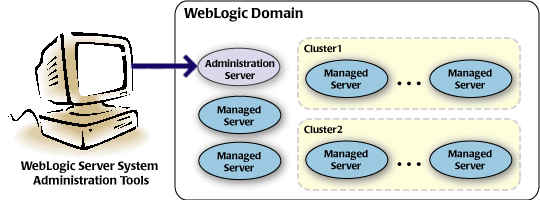Architecture of WebLogic Domain
Author: Will Williams | 3 min read | October 25, 2016
A WebLogic domain is a fundamental administrative unit for WebLogic Server. It comprises one or more WebLogic Server instances with their resources, which are collectively managed and configured using a single Administration Server.
Datavail has just released a whitepaper, Extending WebLogic Domains, that provides detailed instructions on planning, preparing, executing, and verifying a WebLogic extension. This blog post explains the architecture of WebLogic domains, including benefits and drawbacks.
WebLogic Server instances are referred to as Managed Servers, in which Java Enterprise Solutions are deployed. These Managed Servers could be grouped into clusters for load balancing and failover, especially for critical applications. Multiple WebLogic domains could also be set up according to application boundaries, system administrator responsibilities and server’s geographical location. Another alternative is to set up a single domain to manage all WebLogic Server administration activities.
The WebLogic domain infrastructure consists of three parts, as illustrated below:
- Administration Server: Guides the actions of managed servers
- Managed Servers: Stand-alone servers ruled by the Administration Server
- Clusters: Groups of managed servers managed by the Administration Server
Sample WebLogic Domain Infrastructure

Source: http://docs.oracle.com/cd/E21764_01/web.1111/e14140/intro.htm – WLDCW101
The sample configuration illustrated above comprises one Administration Server, two Managed Servers that are not within a cluster, and two clusters each with several Managed Servers.
Below is the outline of the WebLogic domain infrastructure:
- Administration Server: Each WebLogic domain must have one server instance set as the Administration Server. This server performs all the configuration changes of the domain and deployment of applications. The Administration Server centralizes domain management and access provision for all the WebLogic Server administration tools listed below:
- Console: This is the Administration Server’s GUI.
- Security
- Application Deployment
- Domain connectivity
- Managed Servers: These are all server instances that exist in a WebLogic domain apart from the Administration Server. They host application resources and components that are deployed and managed as part of the domain. In a WebLogic domain with only one server, that server will be used as both the Administration Server and the Managed Server.
- Clusters: A Cluster is more than one Managed Server grouped together to provide high availability and scalability for applications. Clustering is important to provide failover whenever a server instance is unavailable. Clustered servers can be run on one machine or multiple machines, but clients perceive the cluster as one single WebLogic Server instance.
The WebLogic infrastructure offers a single, high-performance, highly integrated, and reliable database management solution. WebLogic Domain provides a single development and runtime environment that combines common application infrastructure with user-friendly robust management and an application development framework for portal initiatives, custom development and enterprise application integration.
Are you taking full advantage of the latest hardware architectures and maximizing the value of WebLogic for your organization? If not, Datavail can help. We put an industry-leading Oracle WebLogic team at your fingertips with expertise covering Oracle WebLogic. The combination of a proven delivery model and top-notch experience ensures that we remain your on-demand experts. We’re here for you, 24 hours a day, every day of the year.
